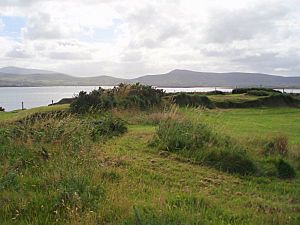Siege of Smerwick facts for kids
Quick facts for kids Siege of Smerwick |
|||||||
|---|---|---|---|---|---|---|---|
| Part of the Second Desmond Rebellion | |||||||
 Map of the English attack on Spanish and Italian forces at Smerwick |
|||||||
|
|||||||
| Belligerents | |||||||
| Papal and Spanish troops | |||||||
| Commanders and leaders | |||||||
| The 14th Baron Grey de Wilton | Sebastiano di San Giuseppe | ||||||
| Strength | |||||||
| ~4,000 | 400–700 | ||||||
The siege of Smerwick was a short but important battle that happened in November 1580. It took place at a place called Ard na Caithne (also known as Smerwick) in Ireland. During this time, a group of soldiers from the Papal States (a country ruled by the Pope) and Spain landed in Ireland. They came to help Irish rebels who were fighting against the English.
These soldiers, about 400 to 700 of them, were forced to go to a nearby fort called Dún an Óir. The English army then surrounded them. After a few days, the Papal commander gave up. Most of the soldiers were then killed by order of the English commander, Arthur Grey.
Contents
Why the Siege Happened
The battle was part of the Second Desmond Rebellion. This was a fight that started in 1579 when James Fitzmaurice Fitzgerald brought a small Papal force to Ireland. The rebellion lasted for three years.
In September 1580, more Spanish and Italian soldiers arrived at Smerwick. They came on ships led by Don Juan Martinez de Recalde. This group had about 600 men and brought many weapons. Their leader was Sebastiano di San Giuseppe. The Pope had sent them to secretly help the rebellion.
At this time, Spain and the Papal States were not officially at war with England. However, the Pope had previously said that Catholics did not have to obey Queen Elizabeth I of England.
Irish rebel leaders like Gerald FitzGerald tried to meet up with these new soldiers to get weapons. But English forces, led by Thomas Butler and Arthur Grey, blocked their way. English ships also stopped the Spanish ships in the bay.
Because of this, Sebastiano di San Giuseppe had to retreat to the fort at Dún an Óir. This fort was just a banked field and had no fresh water.
The Attack Begins
On November 5, 1580, English warships arrived at Smerwick Bay. They brought more supplies and eight cannons for the English army. On November 7, Arthur Grey's forces began to surround the fort.
The soldiers inside the fort were stuck. They were on the very tip of the Dingle Peninsula, with a huge mountain on one side and the large English army on the other. On November 8, the English started firing their cannons at Dún an Óir. The fort's simple defenses quickly broke down.
After three days of fighting, the commander Di San Giuseppe surrendered on November 10.
The Surrender and What Happened Next
After the surrender, there are different stories about what happened. The English commander, Grey de Wilton, ordered that almost everyone be killed. Only the leaders were spared. Grey had also heard that a large Irish rebel army was nearby, waiting for weapons. He worried they might surround his army, but this rebel army never showed up.
Grey de Wilton wrote a report to Queen Elizabeth I. He said that the Spanish and Italian forces wanted to surrender with conditions, meaning they wanted to leave safely. But Grey said he told them they had to surrender completely and trust his decision. He said he refused their request for a break in fighting.
Finally, they agreed to surrender without any conditions the next morning. English soldiers then went into the fort. Grey de Wilton wrote in his report, "Then put I in certain bands, who straight fell to execution. There were six hundred slain." This means 600 people were killed. He said he spared the higher-ranking officers and gave them to his captains.
Some people at the time, like Margaret Anna Cusack, said that Grey de Wilton had promised the soldiers their lives if they surrendered. But then he broke that promise. This was remembered as "Grey's faith."
It was also said that Colonel Sebastian San José, the commander, had been bribed to give up the fort.
Some English officers were present during these events. These included Captain Walter Raleigh and Captain Mackworth, who led the groups carrying out the killings. The famous poet Edmund Spenser, who was a secretary to the English Lord Deputy of Ireland, was also thought to be there.
Local stories say that the killings took two days. Many captives were beheaded in a field known as Gort a Ghearradh ('Field of Cutting'). Their bodies were then thrown into the sea. Another nearby field is called Gort na gCeann ('Field of the Heads').
Later Mentions
Many years later, when Walter Raleigh was in trouble, his part in the Smerwick killings was brought up. He said he had to obey his commander's orders.
Monument
A monument was put up at Smerwick in 1980 to remember the people who died in the massacre. The sculpture was made by an Irish artist named Cliodhna Cussen.
See also
- List of massacres in Ireland



